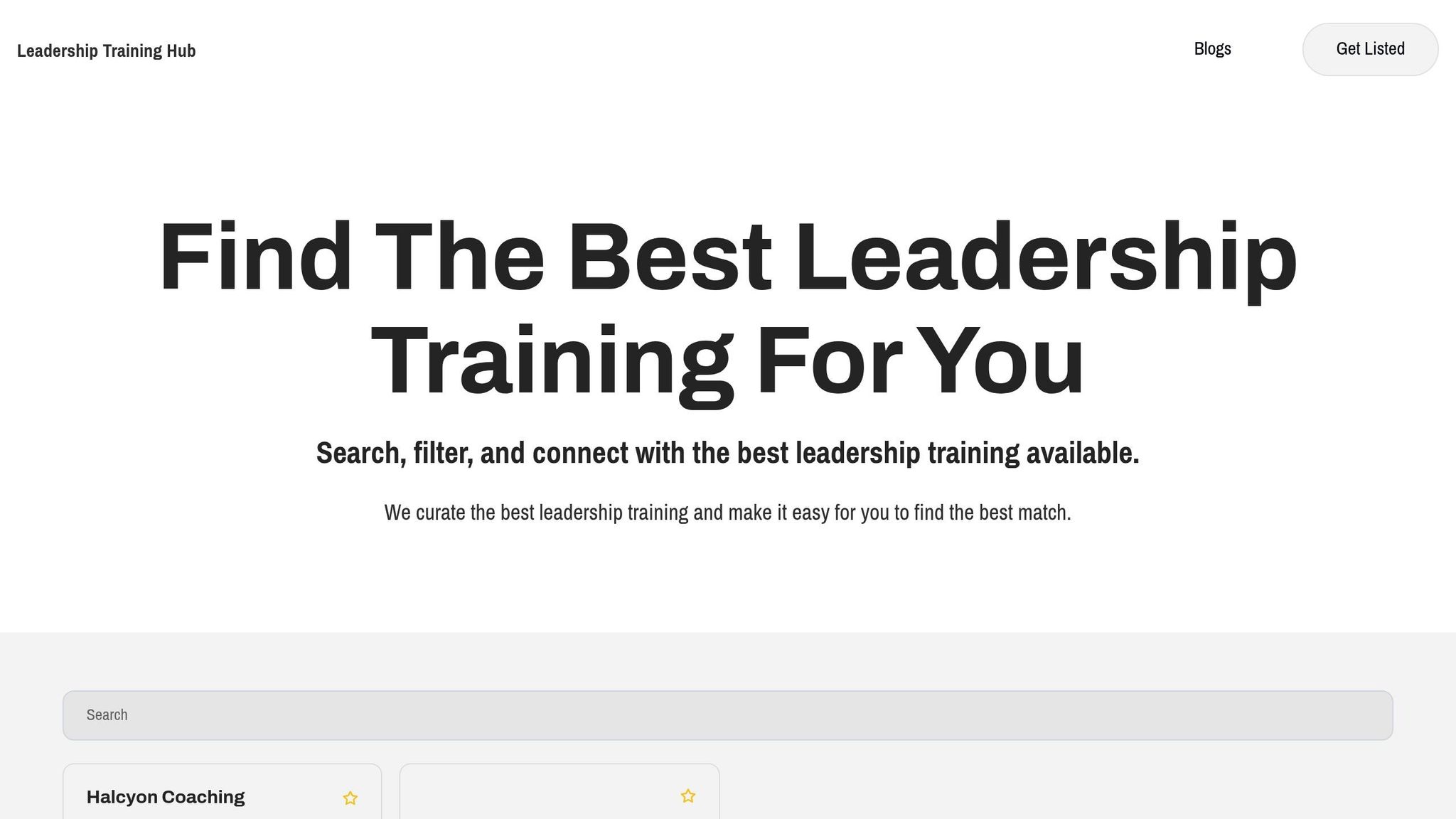Virtual mentoring is transforming leadership in hybrid work environments, where teams split their time between home and office. With 51% of UK workers in hybrid setups by 2024, organisations are using digital tools to connect mentors and mentees across locations. This approach addresses challenges like team disconnection, burnout, and communication gaps, while offering benefits such as increased accessibility, support for diverse employees, and stronger emotional bonds within organisations.
Key takeaways include:
- Building trust: Regular one-on-one meetings and open communication create stronger relationships.
- Psychological safety: Recognising contributions and encouraging shared leadership boosts confidence and inclusion.
- Clear communication: Setting expectations for response times and communication channels avoids confusion.
- Digital tools: Video calls, mentoring platforms, and AI-powered tools streamline mentoring processes.
- Balancing communication: Combining real-time and delayed methods suits different needs and schedules.
Organisations that prioritise virtual mentoring see higher engagement, retention, and leadership development, making it a vital strategy for hybrid teams.
#58: Remote Training and Virtual Mentoring for Hybrid and Remote Teams
Core Principles of Effective Virtual Mentoring
Navigating virtual mentoring in hybrid teams means adopting fresh approaches to maintain meaningful connections, even when separated by distance.
Building Trust and Purposeful Relationships
Trust is the bedrock of any mentoring dynamic, and in virtual settings, it takes deliberate efforts to nurture. Research shows that employees in high-trust organisations are 29% more satisfied with their lives, 74% less stressed, and enjoy greater productivity along with lower burnout rates. On the flip side, 67% of remote workers aged 18 to 34 struggle to maintain relationships with colleagues, highlighting the need for extra attention in hybrid teams.
One-on-one meetings serve as a powerful tool here. Unlike group settings, these personal interactions allow for deeper connections. Michael Li, CEO of the Data Incubator, puts it aptly:
Investing time in meaningful, deep connections with individuals, one-on-one, can be a refreshing change and a chance to establish more authentic connections. Regular virtual one-on-ones provide a unique opportunity for building rapport that isn't possible in group settings.
Being open and sharing personal challenges can also strengthen bonds between mentors and mentees. Video calls, sprinkled with informal chats, create a relaxed and trustworthy atmosphere where these connections can thrive.
Once trust is in place, the focus shifts to fostering a psychologically safe and inclusive environment.
Creating Psychological Safety and Inclusion
Psychological safety is crucial - it allows team members to express themselves, take risks, and learn without fear of judgement. In virtual mentoring, creating this safety net requires extra care to overcome the limitations of digital communication.
Acknowledging and valuing contributions is a key step. Data shows that 79% of mentored employees feel appreciated. Good mentors often make it a habit to recognise achievements publicly while offering constructive feedback privately, striking the right balance.
Encouraging mentees to take the lead in discussions or spearhead projects can also create a sense of inclusion and boost confidence. This practice of shared leadership reduces perceived hierarchies, enhancing trust and satisfaction within virtual teams.
Virtual mentoring is also flexible by nature, accommodating different working styles or time zones. This aligns with Sanghamitra Chaudhuri's belief:
Everyone is a guide because everyone has knowledge to share.
Given the lack of physical cues in digital exchanges, mentors should actively listen and leverage video conferencing tools to ensure clarity. This helps bridge communication gaps and fosters a mutual understanding.
Clear communication and setting expectations are the final pieces of the puzzle.
Setting Clear Expectations and Communication
In hybrid teams, where informal interactions are less frequent, clear expectations and structured communication are critical to avoiding confusion and keeping productivity on track.
Define guidelines for communication - whether it's response times, preferred channels, or the type of discussions suited to each medium. For instance, urgent matters can be handled via instant messaging, while reflective conversations might work better in scheduled video calls or emails.
Transparency in setting goals builds trust and ensures alignment between individual efforts and team objectives. Effective communication in this context requires clarity, empathy, respect, and openness. Regular feedback - whether through check-ins or anonymous surveys - helps both mentors and mentees stay aligned and adapt as needed.
The mentor–mentee relationship often serves as a bridge between personal and organisational goals. As business leadership coach Naz Beheshti explains:
Employees are most productive when their individual needs and the needs of the organisation are in sync... A mentor can be a bridge between individual and organisational needs, between extrinsic and intrinsic rewards.
Best Practices for Virtual Mentoring in Hybrid Environments
Virtual mentoring in a hybrid work setup requires a thoughtful approach to bridge the gap between remote and in-person interactions. With 60% of employees favouring hybrid work over a full-time office presence, organisations need to rethink how they support mentoring in this evolving landscape.
Regular Check-Ins and Feedback Systems
Consistent communication is the backbone of effective virtual mentoring. In traditional office settings, informal conversations happen naturally, but hybrid teams need structured systems to maintain connection and monitor progress.
Scheduling weekly or fortnightly check-ins can help mentors and mentees stay aligned. These sessions should balance formal progress reviews with informal discussions to build rapport. For example, Microsoft’s leadership meetings use written pre-reads to ensure participants are prepared, while shared notes ensure everyone stays informed - even those who don’t attend.
Check-ins should address both professional progress and personal challenges. Research shows that well-connected teams can boost productivity by up to 25%, highlighting the importance of this balance.
Feedback systems also need to be flexible, accommodating different communication styles and time zones. Immediate feedback via messaging can complement more thoughtful responses delivered through email. Studies suggest that allowing time for reflection often results in more meaningful feedback. Regular feedback is especially important in hybrid settings, as such teams are 1.27 times more likely to experience disconnection compared to fully onsite teams. Simple tools like weekly pulse surveys or short check-in forms can help mentors identify early signs of disengagement or isolation.
Using Digital Tools for Scalability
Digital tools play a key role in scaling mentoring programmes without sacrificing quality. By leveraging the right platforms, organisations can turn mentoring into a data-informed and efficient process.
- Video conferencing platforms are essential, but their success depends on thoughtful use. Regular video calls help capture visual cues and improve communication. Features like breakout rooms enable group mentoring, while recording options allow mentees to revisit sessions they missed.
- AI-powered tools can streamline mentoring. For instance, AI note-takers automatically summarise key points from sessions, making it easier for mentees to review important details later.
- Learning Management Systems (LMS) centralise resources, track learning progress, and allow mentors to assign tailored modules. These platforms help identify areas where mentees may need extra support.
- Mentoring software ensures better mentor-mentee matches by aligning goals and interests. Many platforms also provide conversation guides and structured programmes to maintain consistency across relationships.
Selecting the right tools is critical. Choose platforms that integrate smoothly with existing systems and provide adequate training to maximise their potential. Understanding your team’s communication needs ensures that the tools enhance workflows rather than complicate them.
Balancing Real-Time and Delayed Communication
Hybrid mentoring thrives on striking the right balance between synchronous and asynchronous communication. This balance impacts satisfaction levels and the overall success of the programme.
-
Synchronous communication is best for sensitive topics, complex discussions, or urgent matters. As Jaime Teevan, Microsoft’s chief scientist for Experiences and Devices, explains:
Real-time interactions are particularly effective for brainstorming, conflict resolution, and relationship building. However, scheduling across time zones requires careful planning.Synchronous collaboration is great for establishing a rapport and getting to know people. It's also great for converging on meaning if we have disagreements or need to arrive at a consensus.
-
Asynchronous communication offers flexibility, allowing teams to manage their time better and focus on deep work. It’s ideal for reflective discussions, detailed feedback, and solving complex problems that benefit from thoughtful deliberation. As Jeff Teper, Microsoft’s corporate vice president of Microsoft 365 Collaboration, puts it:
The fact that we brought asynchronous and synchronous together in such a seamless way lets people get back more time to be more productive. Instead of sitting in that meeting for an hour, I can get up to speed in five minutes.
To avoid confusion, establish clear communication standards. For example, use email for announcements, video calls for brainstorming, and instant messaging for quick queries. Regularly review your communication strategy to identify gaps and ask team members about their preferences. Features like message scheduling can help maintain work-life balance by avoiding pressure for immediate responses.
The best hybrid mentoring programmes adapt by experimenting with various communication methods and setting norms based on what works. These strategies ensure mentoring remains flexible and responsive to the needs of both mentors and mentees.
sbb-itb-fa39ac2
Common Mistakes and How to Avoid Them
Leaders often face challenges when implementing virtual mentoring for hybrid teams. Recognising and addressing these common missteps can mean the difference between a successful mentoring programme and one that leaves team members feeling disconnected or stressed. These challenges can undermine the trust, inclusion, and communication strategies essential for effective mentoring.
Preventing Isolation and Burnout
One of the biggest hurdles in hybrid mentoring is combating isolation. Remote work can lead to feelings of loneliness and reduced team cohesion, which traditional mentoring methods may not fully address. The numbers are telling: absenteeism linked to stress and loneliness costs U.S. employers around £126 billion annually. On top of that, blurred work-life boundaries in hybrid settings contribute to burnout. Endless virtual meetings only add to the problem, leading to digital fatigue and disengagement.
To tackle this, focus on structured connection points and respect for personal boundaries. Schedule regular one-on-one meetings - not just to discuss work progress, but also to check on workload, concerns, and overall well-being. To ease screen fatigue, allow team members to turn off their cameras or join meetings by phone when possible.
Encourage informal interactions that mimic office camaraderie. For instance, set up monthly online chats with small groups of team members, rotating the hosting duties. Virtual activities like trivia games or escape rooms can also help build rapport. Protect personal time by marking breaks on calendars and encouraging employees to stick to them. Leaders should lead by example - take holiday time and avoid sending work emails outside of regular hours. Encourage staff to voice concerns if they’re working beyond their limits.
Avoiding Over-Monitoring and Miscommunication
Micromanagement is a common trap in virtual mentoring. Without the physical presence of team members, some leaders may become overly focused on monitoring productivity. This can backfire, especially when paired with proximity bias. For example, Gartner found that 64% of managers perceive onsite employees as higher performers, and 75% believe they are more likely to earn promotions. Meanwhile, many remote workers are logging extra hours - 30% of men and 21% of women reported working two or more additional hours daily in 2021.
To avoid this, establish clear communication norms. Define work hours, update expectations, and response time guidelines to ensure clarity without over-monitoring . Regular check-ins can help maintain connections without feeling intrusive. When conflicts arise, address them directly through phone or video calls, rather than relying solely on written communication.
Advocate for hybrid team members by including them in important meetings and decision-making processes. Create digital spaces for casual conversations to reduce isolation and improve communication. Be mindful of time zones when scheduling meetings, and rotate meeting times to distribute any inconvenience fairly.
Measuring Results and Adapting Methods
Measuring the success of mentoring programmes is key to ensuring their effectiveness. Many initiatives falter due to poor tracking or resistance to change. McKinsey reports that 49% of employees are experiencing burnout, often because organisations stick with ineffective methods. Engagement metrics can act as early warning signs - highly engaged teams, for example, see 21% higher profitability.
Track participation in mentoring sessions, response times to communications, and the completion of development activities. Regular well-being surveys and anonymous feedback channels can provide insights into how mentoring impacts mental health, focusing on workload balance, stress levels, and team connections .
Also, assess the effectiveness of your technology platforms. Are they enabling meaningful connections and supporting engagement? If not, consider alternatives. Support career growth by discussing goals, offering training opportunities, and monitoring mentees’ progress. Adjust your mentoring approach if mentees aren’t advancing as expected.
Balancing data with personal feedback is crucial. While metrics can show what’s happening, conversations with participants often reveal why. This combination allows you to refine your mentoring strategy and make it more impactful.
Using Leadership Training Hub Resources

Choosing the right mentoring programmes for hybrid teams can be a tricky task. Leadership Training Hub makes it easier by connecting organisations with providers who specialise in virtual mentoring. With nearly 90% of organisations planning to adopt a hybrid model, having access to tailored resources is essential for building effective leadership in these unique work environments.
The platform acts as a directory, matching organisations with leadership development providers based on specific needs, budgets, and team sizes. This ensures your mentoring programme directly addresses the challenges your hybrid team faces, rather than relying on generic solutions that may not work well in virtual settings. Let’s dive into how you can find the perfect mentoring programme for your team.
Finding Mentoring Programmes
Leadership Training Hub helps you find mentoring programmes designed to tackle the challenges of leading hybrid teams. The platform connects users with providers who focus on critical skills like emotional intelligence, team agility, and leading through change.
You can use filters to narrow your search and find providers who specialise in areas such as building psychological safety. For example, if your team struggles with creating a sense of trust and openness across virtual and in-person settings, you can identify programmes specifically designed to address this need.
Take Pitney Bowes as an example. Their participants were "pleasantly surprised at the structure and effectiveness of the virtual programme, and most enjoyed collaborating and learning from colleagues across the global organisation". This success came from choosing a programme tailored for virtual collaboration, rather than trying to adapt traditional in-person methods. This kind of targeted selection can make all the difference.
Accessing Leadership Development Resources
To complement your mentoring programme, Leadership Training Hub offers resources designed to strengthen hybrid leadership skills. These include tools and training on self-awareness, emotional intelligence, effective communication, and psychological safety - skills that are essential for managing teams split between remote and office work.
The platform’s providers offer structured modules that focus on key areas such as building trust in hybrid settings, improving emotional intelligence for digital communication, and fostering collaboration in mixed work environments. These programmes are based on research and proven strategies.
Hybrid leadership requires a different approach compared to traditional management. As Suzie Bishop, Vice President of Product Development at The Center for Leadership Studies, puts it:
Foundation skills are the same - managing the balance of success and engagement, open communication and transparency, clear standards, collaboration - but the importance of adaptability and intentionality increases. There's an extra effort that goes into developing a relationship now because the other individual isn't just right there; you have to seek it out or put in the extra time.
To reflect the realities of hybrid work, many providers offer flexible learning options. These include micro-learning modules that fit into short breaks, leader-led groups that meet virtually or in person, and assessments to identify individual strengths and communication styles.
Customising Solutions for Different Needs
Leadership Training Hub also excels at helping organisations customise mentoring solutions to align with their unique goals and challenges. This is particularly important for hybrid teams, whose needs differ significantly from those of fully office-based or remote teams. Customisation ensures that senior leaders, middle managers, and team leads all receive relevant training tailored to their specific roles and challenges.
Pricing options range from free access to premium plans at £299, £999, and £2,999, making it accessible for organisations of all sizes.
Crowley Maritime’s experience highlights the value of customisation. With a team spread across multiple time zones and countries, they found that a virtual programme was not only the best fit but also made the experience more engaging. Team members interacted more frequently, supported one another, and developed key leadership skills. Gloriana Garro, their Director of People Development & Learning, shared:
The virtual experience was the best solution for our needs.
The platform’s providers also offer learning reinforcement options, such as micro-learning and leader-led groups, to ensure lasting impact. These features are particularly helpful for hybrid teams, where leadership challenges evolve as work modes shift between remote and in-person settings. Customised learning environments also help leaders discover their unique leadership style and maximise their impact in hybrid contexts, adapting communication strategies to suit both virtual and face-to-face interactions within the same day.
Conclusion
Virtual mentoring has become a game-changer for hybrid teams, offering a clear path to stronger leadership and improved team performance. Companies with structured mentoring programmes see an 18% boost in profits, while those without mentoring can experience up to 45% lower profits. With 74% of businesses now embracing hybrid work models, effective virtual mentoring is no longer optional - it’s a necessity.
The shift to hybrid work has redefined how professionals connect and grow. As highlighted by Harvard Business Review:
Virtual mentoring encourages people to connect with experts across multiple domains, which ultimately helps people broaden their network, become more innovative, and feel more connected to their organization.
This evolution demands immediate attention to refining mentoring approaches to suit this new reality.
Key Takeaways
- Trust and psychological safety are critical. Without the natural ease of face-to-face interactions, leaders must create intentional spaces where team members feel comfortable sharing challenges and seeking guidance. Building trust requires consistent communication and structured efforts to foster relationships.
- Digital tools are essential for hybrid mentoring success. Video calls improve engagement and foster personal connections, while project management platforms help keep everything organised and on track. Ensuring all team members have access to the right tools prevents technology gaps from derailing progress.
- Clear and structured communication is vital for keeping hybrid teams connected. Setting SMART goals provides direction, and regular check-ins ensure momentum is maintained. Balancing live interactions with asynchronous communication accommodates varying schedules and work styles.
- Flexibility in approach is key. Effective mentoring programmes blend virtual and in-person options, match mentors and mentees based on individual goals, and encourage networks that extend beyond one-on-one relationships. This adaptability is particularly important, as 60% of employees prefer hybrid work over full-time onsite roles.
Leadership Training Hub offers resources to help organisations tailor mentoring programmes to meet the unique challenges of hybrid teams. Its customisation features ensure solutions are specific to each organisation’s needs, avoiding generic approaches that may fall short.
Practical Next Steps
- Define clear objectives that align with your organisation’s goals. Use the SMART framework to set measurable outcomes, ensuring both accountability and room for programme growth.
- Evaluate your technology setup and communication practices. Make sure all team members have equal access to necessary tools, and establish clear guidelines for communication frequency and methods. A ‘remote-first’ mindset can help ensure inclusivity in hybrid mentoring.
- Collect regular feedback to refine your mentoring programme. Continuous feedback allows you to address challenges and adapt as your hybrid model evolves.
- Provide mentor training focused on virtual relationship-building, effective digital communication, and creating a psychologically safe environment. Recognising and equipping mentors is crucial, especially since over 90% of professionals say mentoring improves their leadership skills.
- Develop robust measurement systems to track success. Monitor both quantitative metrics (like retention rates and engagement levels) and qualitative outcomes (such as leadership growth and team cohesion). For instance, Enterprise Rent-A-Car achieved retention rates of over 89% for mentoring pairs, including 94% retention for women and minorities.
Virtual mentoring is the future of leadership development. With mentoring programmes boosting employee retention by over 50% compared to those without, investing in this area strengthens talent retention, leadership growth, and organisational resilience. The key lies in thoughtful implementation and a willingness to adapt as team needs evolve.
FAQs
How can organisations build trust and psychological safety through virtual mentoring in hybrid teams?
To strengthen trust and create a sense of psychological safety in hybrid teams through virtual mentoring, organisations should emphasise open communication and nurture a culture built on honesty and mutual respect. Leaders play a crucial role here, setting an example by being transparent about their own challenges and encouraging team members to share their thoughts freely.
Practical actions can include making sure everyone - whether working remotely or in the office - has an equal chance to participate in discussions. Setting clear expectations and offering feedback in a positive, constructive way also helps to foster an environment where people feel appreciated and confident to share ideas without fear of criticism.
By focusing on these approaches, organisations can build stronger team bonds and improve the mentoring experience in a hybrid work environment.
How can you effectively balance real-time and flexible communication in a virtual mentoring programme?
Striking a balance between real-time interaction and more flexible communication is key to running a successful virtual mentoring programme. Regular live sessions, like video calls or online chats, are great for building trust and tackling immediate issues. Pair these with more flexible options - such as emails, shared documents, or recorded videos - that give mentees the chance to process information and engage on their own schedule.
From the outset, establish clear communication guidelines so both mentors and mentees know when to use live (synchronous) or flexible (asynchronous) tools. Combining regular feedback with a variety of communication methods helps maintain trust and keeps the mentoring relationship engaging and productive.
How can digital tools improve the scalability and success of mentoring programmes in hybrid workplaces?
Digital tools are essential for the growth and effectiveness of mentoring programmes in hybrid work environments. They ensure smooth communication and collaboration, whether teams are working in person or remotely, making mentoring more inclusive and adaptable.
Take video conferencing platforms like Zoom or Microsoft Teams as an example - they enable meaningful face-to-face conversations no matter where participants are located. Meanwhile, tools like virtual whiteboards and project management software keep engagement high and make it easy to share resources. These technologies strengthen mentor-mentee connections and allow programmes to expand seamlessly, even across teams spread out over different locations.
By using the right mix of digital tools, organisations can create mentoring experiences that blend in-person and virtual interactions, helping everyone involved feel connected and well-supported.


